Written by Sig Silber
HEADLINES (Updated 5:09 PM EST) –
– Impactful ice and snow to come to an end overnight across the Midwest and Great Lakes, while continuing throughout northern New England Saturday
– Another round of wintry precipitation to enter the Northeast and Oho Valley later this weekend
– More stormy weather for the Pacific Northwest with heavy lower elevation rains and heavy mountain snows throughout the Cascades and Northern Rockies

This article provides continuous updates for a variety of Weather and Weather-Related Threats as well as a general weather forecast. These are “Live” maps that continually update. Please pay attention to the Mesoscale Events maps — Mesoscale Events are potentially life-threatening situations.
Please share this article – Go to the very top of the page, right-hand side for social media buttons. Also, feel free to send this email to anyone you feel will benefit from it.
For those interested in longer-term forecasts, we just published the new NOAA Seasonal Outlook and it can be accessed here.
Readers can scan through this article or jump to where they want to go via the links to the right. To get back to the Directory, hit the back arrow at the top of the URL bar on your screen. But in many cases, one of my Editors has graciously inserted a Return to Directory link to click so that is even easier. This is so high tech that I hardly believe it. |
|
CONUS Focal Points
Short Range Focal Points
Short Range Forecast Discussion NWS Weather Prediction Center College Park MD – 226 PM EST Fri Jan 01 2021
Valid 00Z Sat Jan 02 2021 – 00Z Mon Jan 04 2021
…Impactful ice and snow to come to an end overnight across the Midwest and Great Lakes, while continuing throughout northern New England Saturday…
…Another round of wintry precipitation to enter the Northeast and Oho Valley later this weekend…
…More stormy weather for the Pacific Northwest with heavy lower elevation rains and heavy mountain snows throughout the Cascades and Northern Rockies…
A very active and stormy weather pattern will prevail across portions of the U.S. as we ring in the new year. A low pressure system currently located over southern Illinois is forecast to move through the lower Great Lakes and New England with numerous winter weather-related hazards between tonight and Saturday. On the northwest flank of this storm system, a swath of snow and freezing rain is expected to stretch from the Midwest this evening to the interior Northeast by tonight and into the weekend. Over a quarter inch of ice accretion has already occurred today from southwest Missouri to northern Indiana. Most of the freezing rain that has yet to fall will do so across the interior Northeast tonight, where up to a quarter inch of ice is possible. As the low advances off toward New England and begins to strengthen on Saturday, heavier amounts of snow (up to twelve inches) is forecast for the interior sections of northern New England before the system moves away into the Canadian Maritimes Saturday night. Winter Storm Warnings, Winter Weather Advisories, and Ice Storm Warnings are in effect for the impacted areas.
Behind this system, another area of low pressure is forecast to develop rapidly across the Southeast along a trailing cold front Saturday night. This system will bring additional thunderstorms across the Southeast and wintry precipitation into the Ohio Valley and Northeast by Sunday morning. Another light coating of freezing rain will be possible across the Interior Northeast, with a few inches of snow forecast across the region as well. Snow will extend into southern New England by Sunday evening.
Across the Pacific Northwest and into the northern Rockies, the next in a seemingly unending series of Pacific cold fronts will arrive and drive strong onshore flow and moisture transport for heavy lower elevation rainfall and heavy mountain snows. In fact, portions of the Washington Cascades and the northern Rockies should see an additional one to two feet of snow going into the weekend. Coastal hazards, such as high surf and high winds, will also be a concern for the Pacific Northwest.
Overall, central and southwest portions of the nation will see relatively mild temperatures this weekend as much of the air across the nation will be of Pacific origin, with a continued lack of Arctic air surging south from Canada. The exceptions to this will be across parts of the southern U.S., where clouds and precipitation will help keep temperatures a bit below normal.
Happy New Year from all of us at WPC!!
We try to keep this up to date but if is not you can find the updated version here.
When you click on this image it takes you to the SPC Fire Warning Page and you get a set of maps for Days 1, 2, 3 – 8, etc. You can then click on those for more detailed information. The map is a bit blurry as I tried to make it a bit larger than the map provided by NOAA but should be able to see where the current wildfire risks are. But if you click on this map, you will get to see three maps that show the risk for different time periods.
Thunderstorm Risk
This should play out something like shown in this 60 Hour Forecast Animation
Here is a national animation of weather fronts and precipitation forecasts with four 6-hour projections of the conditions that will apply covering the next 24 hours and a second day of two 12-hour projections the second of which is the forecast for 48 hours out and to the extent it applies for 12 hours, this animation is intended to provide coverage out to 60 hours. Beyond 60 hours, additional maps are available at links provided below. The explanation for the coding used in these maps, i.e. the full legend, can be found here although it includes some symbols that are no longer shown in the graphic because they are implemented by color-coding.

The two maps below break it down by day and may be easier to read.
Now, the Day One and Two CONUS Forecasts: These Maps Update Daily.
Day One CONUS Forecast | Day Two CONUS Forecast |
These graphics update and can be clicked on to enlarge. You can see where the weather will be | |
 | |
During the winter much of our weather originates in the Pacific. That is why we pay attention to the near-term history of storms arriving.
Temperature
A version that shows a 20 hour animation and some other views can be found here

– Return to Directory
Day 3 – 7 Hazards
Valid Monday January 04 2021 – Friday January 08 2021
Hazards:
– Heavy precipitation across portions of California, the Pacific Northwest, and the Northern Great Basin, Mon-Thu, Jan 4-Jan 7.
– Heavy precipitation across portions of the Central Great Basin, California, and the Southwest, Mon, Jan 4 and Wed-Thu, Jan 6-Jan 7.
– Heavy precipitation across portions of the Southeast, the Southern Appalachians, the Mid-Atlantic, and the Central Appalachians, Thu-Fri, Jan 7-Jan 8.
– Heavy snow across portions of the Northern Rockies and the Northern Great Basin, Mon-Thu, Jan 4-Jan 7.
– Heavy snow across portions of the Central Rockies, the Northeast, the Central Great Basin, the Northern Rockies, and the Northern Great Basin, Mon-Tue, Jan 4-Jan 5.
– Flooding possible across portions of the Southeast, the Middle Mississippi Valley, the Mid-Atlantic, and the Ohio Valley.
– Flooding likely across portions of the Pacific Northwest.
– High significant wave heights for coastal portions of California and the Pacific Northwest, Mon, Jan 4 and Wed-Thu, Jan 6-Jan 7.
– Heavy precipitation across portions of the Alaska Panhandle and mainland Alaska, Tue-Thu, Jan 5-Jan 7.
– Heavy precipitation across portions of the Alaska Panhandle, Tue-Wed, Jan 5-Jan 6.
Detailed Summary:
The upper level pattern from the North Pacific to the North Atlantic will be undergoing substantial changes during the medium range period (Mon, Jan. 4 to Fri, Jan. 8). As the week progresses, a blocking ridge pattern begins to take shape over the North Atlantic with anomalously high 500mb heights extending west towards the Davis Strait. Meanwhile, a retracting North Pacific jet streak will force heights to build over western Canada and an upper low to deepen in the Gulf of Alaska. The resulting weather pattern across the Lower 48 goes from one of transitory waves at the start of the week to a larger scale blocking pattern by the start of next weekend with much above normal heights over Canada and an increasingly active storm track from the South-Central U.S. to the East Coast.
The impressive jet streak stretching from central China to the North Pacific is the reason for the onslaught of rain and mountain snow along the West Coast. Powerful low pressure systems swinging through the Gulf of Alaska are tapping into a rich reservoir of sub-tropical moisture and directing them at the Pacific Northwest. Copious amounts of rain are forecast along coastal sections of the Northwest and northern California, with potentially feet of snow falling across the Sierra and Cascade mountains on Monday and again Wednesday into Thursday. Significant waves and even some strong winds could lead to coastal hazards across the Northwest during this time period, especially around mid-week. Heavy snow is also forecast from the northern Rockies of Idaho and Montana on south to the Tetons and Wasatch this upcoming week. Precipitation may linger into the end of the week in the Northwest, but upper level ridging building in and should begin to scale back the influx of Pacific moisture into the Northwest.
To the east, the forecast calls for an area of low pressure to weaken over the eastern Great Lakes Sunday night and a potent area of low pressure to develop in the Gulf of Maine the first half of the week. Operational model guidance remain at odds on the track, longevity, and thermodynamic profiles along the New England coast with varying locations of where the 850mb low tracks. The CMC and GFS are closer to one another while the Euro is more offshore. Both the GEFS and Canadian ensemble means are slightly farther east than the operational runs. The coastal areas could become located beneath the deformation axis and any slight change closer to or away from the coast could mean drastic changes in snowfall totals. Interests in New England will certainly want to keep an eye on the forecast throughout the weekend as snowfall totals are likely to be heavy under the deformation axis and with disruptive conditions to travel possible.
Meanwhile, an upper level trough responsible for the heavy rain and mountain snow to start the week heads east reaching the central Plains by mid-week. At the same time, the low pressure system producing heavy snow in New England heads slowly east. Confluent flow over southeast Canada forces high pressure to strengthen as it begins to inch closer to the northern Great Lakes and New England late week. In addition, an intensifying jet streak over the Gulf Coast that in turn would position the favorable left-exit region over the TN Valley and towards the Mid-Atlantic, allowing for precipitation associated with an area of low pressure to breakout from the Mid-South to the Mid-Atlantic. There is still a great deal of uncertainty on this setup late week (timing/intensity of the central U.S. trough, strength/positioning of intense upper low east of Nova Scotia, strength of confluent flow over southeast Canada) but the setup does support the opportunity for disruptive wintry weather from parts of the OH/TN Valleys to the East Coast. For now, I have chosen to introduce a heavy precipitation area over the southern and central Appalachians but this forecast is subject to change. Should the central U.S. trough become increasingly flatter in the coming days, less precipitation and wintry impacts would ensue. If the trough were to deepen, however, the potential for a more impactful late week winter storm would become more apparent.
In Alaska, an active storm track will be the story as wave upon wave of low pressure tracks through the Gulf of Alaska. Ensemble means are pointing to a sub 960mb low tracking south of the southwestern peninsula by Monday night and a rich supply of moisture aimed at the southern coast and the Alaskan Panhandle. Heavy mountain snowfall would transpire along with periods of rain in the valleys and along the coast. Gusty winds and rough surf along the coasts are also a concern but and may even challenge thresholds, but most ensemble guidance keeps winds just shy of high wind criteria for now. The second half of the week should lead to more rain and snow along the south-central coast but exact amounts are lower confidence at this time. Milder temperatures return to much of the interior locations later in the week as mild Pacific air races in ahead of these storm systems.
(This is updated only during the week) Note the first list is weather highlights, this list is hazards. Not sure there is that much of a difference but they come from two different parts of NOAA. The Day 3 – 7 Hazards List does not update on weekends. But it is still useful as it remains valid for the period of time it covers. Of course, all forecasts are subject to change. Later we show a map of the hazards. Perhaps we should show them together.
Click here for the latest complete Day 3 -7 Hazards forecast which updates only on weekdays. It includes the full discussion which I do not update in this article but only present the highlights.
– Return to Directory
Ski Snow Reports
New Feature – Ski Reports. (We may be a tad premature but not by much). It is difficult to find reports that auto-update on-screen (and they are very long) but these links will get you to them – If you have additional suggestions make them in the comments section after every GEI Article and we may add those links. We will try to not have too much overlap as that can add to the confusion.

We will update the above map weekly but more frequent updates can be obtained here.
Snow Forecasts.
Day 1

Day 2

Additional snow information can be found here and here.
We also include drought information in this section.


New December Drought Outlook

Seasonal Outlook Issued November 19, 2020

– Return to Directory
Tropical Events
I am replacing the large with three small maps but you can click on them to get larger versions. Even though they are small maps you should be able to tell if there is activity and If I see activity I will make the map where there is activity full size and when available add other related maps.
| the Central Pacific. | the Eastern Pacific | the Atlantic and the Gulf of Mexico |
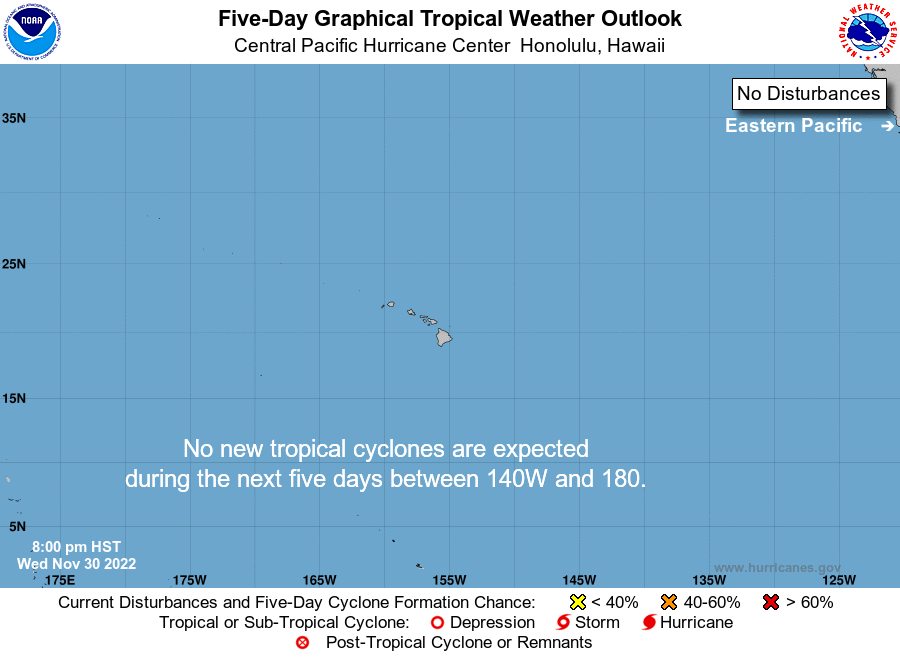 | 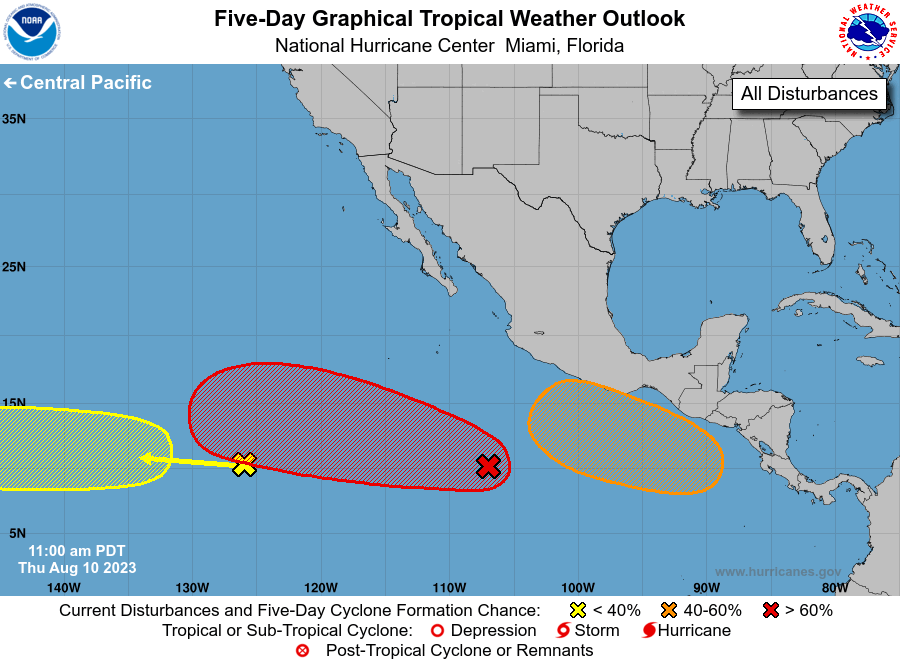 |  |
Atlantic and Gulf of Mexico
And the Eastern Pacific
Updates on individual named storms can be obtained here.
And the Western Pacific


Weekly Tropical Forecast

– Return to Directory
Intermediate-Term Weather Forecast
And shifting to the Alaska and CONUS Intermediate-Term Weather Forecast showing from left to right, Days 1- 5, 6 – 10, 8 – 14 and Weeks 3 – 4 You can click on these maps to have them enlarge, there are larger versions in the Addendum (More Weather the link is shown at the end of this section, and there are larger versions of these maps in the Addendum. Also, the discussions that go with these forecast maps can be found here (first two weeks) and here (Weeks 3 and 4).
First Temperature
And then Precipitation
For those interested in more detail, there are additional weather maps and information in the MORE WEATHER Addendum. The link to the Addendum is here. |
– Return to Directory
Mesoscale Events
The following map shows where mesoscale events are occurring or forecast. If you do not see any areas highlight on this map than there are no mesoscale events taking place or forecast. A mesoscale event is a very serious situation for a very small area and detailed information is provided for these events when they occur or are forecast. If a mesoscale event is shown, click on the map and more detail on the event will be shown.
Two different parts of the NWS issue this map and they are not always in agreement although they are pretty close. They (Norman Oklahoma and College Park Maryland) issue the alerts when they realize the need, so it is best to look on both maps and click one or both if you see areas highlighted.
This next map showing where “Headlines” have been issued for convection (and an animation of the recent movement of storms) should update and you should be able to click on to get additional details but if it does not update when you click on it, click here.
There is a slight difference between convection and thunderstorms. The below map shows where “Headlines” have been issued for Thunderstorms. You should be able to click on the map to get additional details but if it does not update, you can click here.
The map below shows the current wildfire risk which becomes more significant as we move into Summer. When you click on this image it takes you to the SPC Fire Warning Page and you get a set of maps for Days 1, 2, 3 – 8, etc. You can then click on those for more detailed information. The map is a bit blurry as I tried to make it a bit larger than the map provided by NOAA but should be able to see where the current wildfire risks are. But if you click on this map, you will get to see three maps that show the risk for different time periods.
– Return to Directory
Now the Day 3 – 7 Hazards Outlook Maps

The orange and red outlined areas are what is most concerning of the forecasted Day 3 – 7 Hazards. This graphic does not update during the weekend. There is a discussion that goes with this graphic and you can access that discussion here.
The following is provided to help the reader relate the maps to how NWS will describe an area of the U.S.

– Return to Directory
Now to our More Detailed Weather Report
This graphic is about Atmospheric Rivers i.e. thick concentrated movements of water moisture. More explanation on Atmospheric Rivers can be found by clicking here or if you want more theoretical information by clicking here. The idea is that we have now concluded that moisture often moves via narrow but deep channels in the atmosphere (especially when the source of the moisture is over water) rather than being very spread out. This raises the potential for extreme precipitation events.
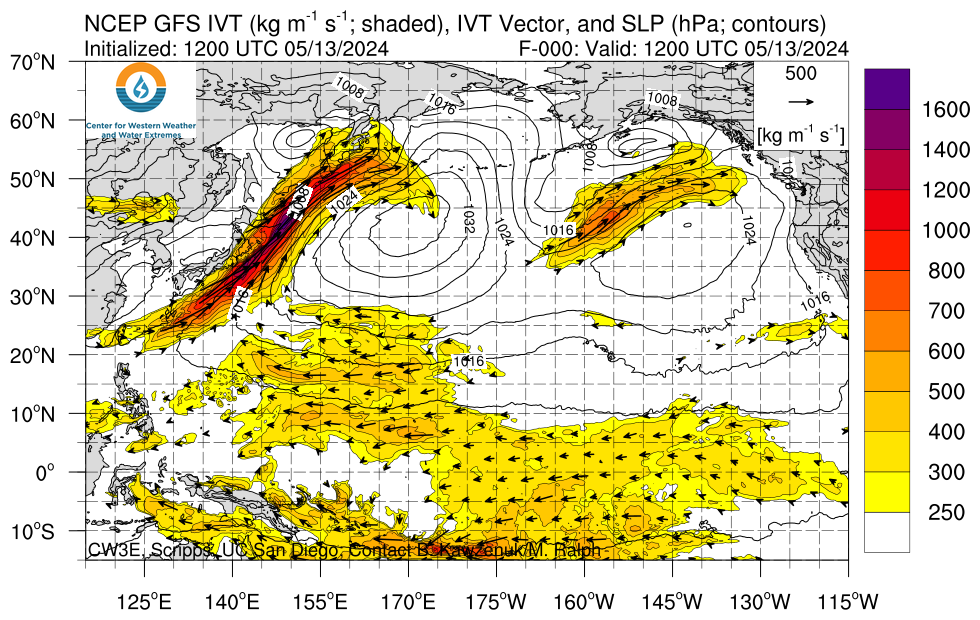
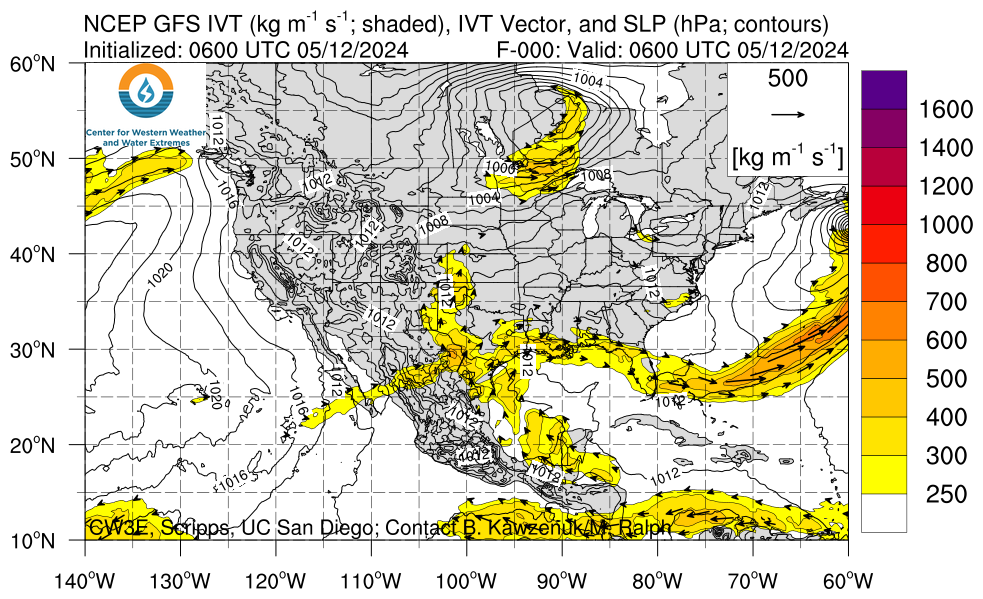
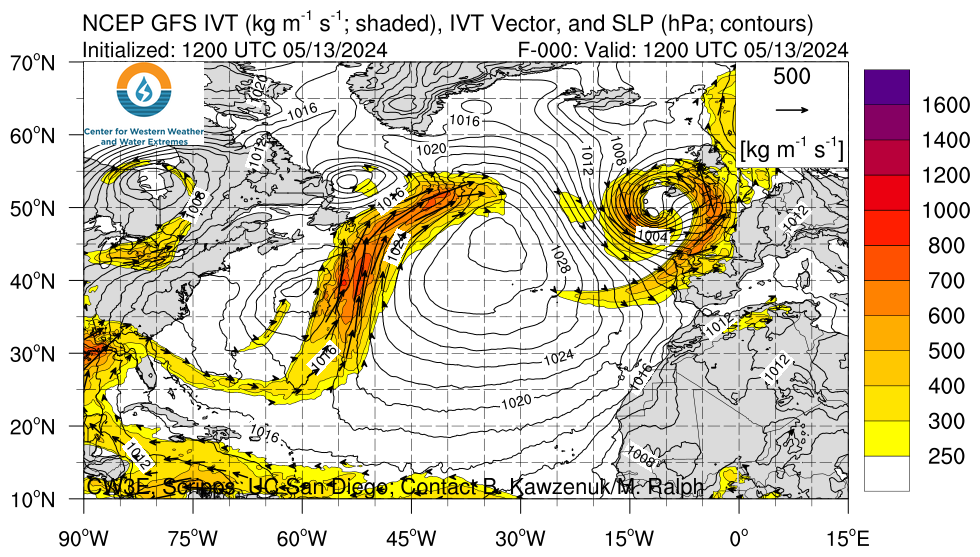
500 MB Mid-Atmosphere View
The map below is the mid-atmosphere 3-Day chart rather than the surface highs and lows and weather features. In some cases, it provides a clearer less confusing picture as it shows only the major pressure gradients. This graphic auto-updates so when you look at it you will see NOAA’s latest thinking. The speed at which these troughs and ridges travel across the nation will determine the timing of weather impacts. This graphic auto-updates I think every six hours and it changes a lot. Thinking about clockwise movements around High-Pressure Systems and counterclockwise movements around Low-Pressure Systems provides a lot of information.


| Day 3 Above, 6 Below | Day 4 Above,7 Below | Day 5 Above. |
 |  |  |
 |  |  |
Here are the precipitation forecasts. First the cumulative for Days 1 – 3

Then cumulative for Days 1 – 5
Then cumulative for Days 1 – 7

Now we look at the forecast for the Maximum Temperature three days out.
Looking ahead to next week.

– Return to Directory
Additional Tools to Obtain Watches and Warnings
| Current watches, warnings, and advisories issued by the agencies of the National Weather Service. Hazards should show up in the various maps but the below links will take you to all outstanding watches and warnings in each category which may include some categories not covered in the various maps or difficult to find. So if there is a category of interest, click on the appropriate link below. |
|
Below you will see a number of different maps that are updated in real-time, making this a “live” report. If a part of one or more of the maps shows an area that is highlighted, you can click on it and get the full current report. By having the reader click on these active situations rather than having GEI do so, you will not miss any events in which you might have an interest and which we had not noticed and the page will not get cluttered with warnings, etc that have since expired.
Our focus here is events that are likely to last in the range of six hours but there can be longer or shorter events that are addressed by the Storm Prediction Center which is the main source of the information in this article. Long-term major events like a Hurricane are more likely to be in a separate article. But that may not always be the case. Since in general, all the links on this page transfer you into the NOAA system, in order to get back into this article you need to either close the tab to which you were transferred or click back on the tab that has this article.
| Live Warning Maps which If Severe Weather is Shown can be Clicked on to get more detail about these events. If there is a current warning shown on the map, click on the map for additional information related to the event. | These maps are updated as risks are identified. |
| This is the current graphic showing any mesoscale discussions (MD’s) which are in effect over the contiguous United States. Please read the description of the purpose of our MD’s for further information. Details on all valid MD’s may be found on our Current Mesoscale Discussions page. |  |
| Convective Outlooks | |
|---|---|
| This is today’s forecast for organized severe thunderstorms over the contiguous United States. Please read the description of the risk categories for further information. You may find the latest Day 1 Outlook available as well as all Outlooks issued today online. | Today’s Outlook |
 | |
| This is tomorrow’s forecast for organized severe thunderstorms over the contiguous United States. Please read the description of the risk categories for further information. The latest Day 2 Outlook is available as well as all Outlooks that have been issued today. | Tomorrow’s Outlook |
 | |
| This is the day after tomorrow’s (day 3) forecast for organized severe thunderstorms over the contiguous United States. Please read the description of the risk categories for further information. The latest Day 3 Outlook is available as well as all Outlooks that have been issued today. | Day 3 Outlook |
 | |
| This is the day 4-8 forecast for organized severe thunderstorms over the contiguous United States. The latest Day 4-8 Outlook is available as well as all Outlooks that have been issued today. Note: A severe weather area depicted in the Day 4-8 period indicates a 30% or higher probability for severe thunderstorms (e.g. a 30% chance that a severe thunderstorm will occur within 25 miles of any point). | Day 4-8 Outlook |
 | |
| The Thunderstorm Outlooks depict the probability of thunderstorms across the contiguous United States in 4 or 8 hour time periods. The probabilistic forecast directly expresses the best estimate of a thunderstorm occurring within 12 miles of a point. The three probabilistic forecast thresholds are 10, 40, and 70 percent. | Thunderstorm Outlook |
 | |
| Fire Weather Outlooks | |
| This is today’s forecast for organized wildfires over the contiguous United States. Please read the description of the risk categories for further information about this product. | Today’s Outlook |
 | |
| This is tomorrow’s forecast for organized wildfires over the contiguous United States. Please read the description of the risk categories for further information about this product. | Tomorrow’s Outlook |
 | |
| This is day 3-8 forecast for organized wildfires over the contiguous United States. Please read the description of the risk categories for further information about this product. | Day 3-8 Outlook |
 | |























